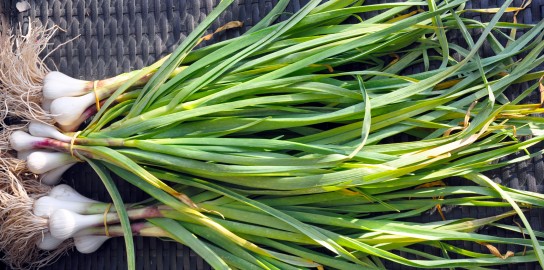Real Food Encyclopedia | Garlic Scapes
If there ever was a poster child for seasonal food, it would be, hands down, the garlic scape. With a tangle of green curlicued shoots in your midst, you aren’t just eating seasonally; you’re literally eating in the moment. The scape (aka garlic shoot or curl) represents a specific stage of growth of hard-necked varieties of garlic. Like its brothers and sisters in the Allium family, garlic (A. sativum) grows underground, developing into a soft bulb. As the bulb grows and hardens, a green shoot pokes its head through the ground and curls in pig tail-like fashion before straightening.
The scape is also a quintessential example of “nose-to-tail” vegetable eating. Snip while curly and you’ve got mild garlicky goodness with an asparagus-like texture and versatile appeal. Ignored, the scape hardens into what we know as the garlic stalk (or neck) and the bulb below never reaches its full potential.
Fun Facts about Garlic Scapes
- Native to central Asia, garlic eventually made its way to the Mediterranean, where it remains a central ingredient of the region’s heart-healthy, disease-fighting diet. It is believed to have made its way to North America via European settlers during colonial times and revered for its medicinal rather than culinary benefits until the early 20th century.
- Devotees of Lord Krishna, also known as Vaishnavas, abstain from garlic because it is considered a distraction to devotion practices. Similarly, in Ayurvedic medicine, garlic is considered rajasic, which means it may stimulate passion, a detour from meditation.
What to Look for When Buying Garlic Scapes
Scapes should be firm but somewhat flexible and free of blemishes or moldy spots. As they age, scapes will fade and brown, similar to what happens with a scallion.
Sustainability of Garlic Scapes
The scape represents a stage in the lifespan of the garlic plant, so it’s like an early birthday present from Mother Nature. It’s rare to get two plants for the environmental price of one, so to speak. You’ll likely only be able to find scapes through farms stands, CSA boxes or farmers’ markets, which keeps the fossil fuel impact down and food dollars in local communities.
Garlic Scapes Seasonality
Garlic scapes generally make their brief appearances in late spring, staying on only fleetingly through early summer.
Garlic Scapes and Geography
You can’t talk about garlic scapes in the absence of garlic, one of the oldest known cultivated vegetables. (In fact, there’s little out there about the history and lore of the scape.) There are references to garlic in the Bible and the Koran, and it’s mentioned as part of the diet on Sumerian cuneiform tablets dating to 2300 BCE. It was used as both a funereal offering and embalming agent in ancient Egypt.
China is the world’s leading producer of garlic, responsible for more than three-fourths of the global supply in 2010. It’s anyone’s guess just how soon we’ll see imported scapes in American supermarkets — another reason to enjoy scapes from local farms!
Most American garlic is grown in central California, in the town of Gilroy, home to a renowned garlic festival. Although Gilroy describes itself as the “garlic capital of the world,” the United States is currently number six in worldwide production, contributing just 1.4 percent of the garlic equation.
Eating Garlic Scapes
Storing Garlic Scapes
Store in the refrigerator and use within a week, as the stalks will eventually soften and lose their punch. Trim the end that was formerly attached to the bulb and discard the flowery blossom, as it tends to be stringy. You could also blanch (quick boil) for 60 seconds, followed by an ice bath, then freeze for when you get a scapes hankering later this year (and you will).
Cooking with Garlic Scapes
Slice thinly (about one-fourth-inch pieces) and use like your other favorite allium friends. Sauté and incorporate into fried rice, omelets, stir-fries or as a pizza topping. Try them pickled, but really what we wait for all year long is to make batches of pesto — to be tossed into pasta, spread onto sandwiches, lathered onto bruschetta and dipped with grilled vegetables.
Garlic Scapes Nutrition
Bulb garlic has long been known for its healing properties, a motherlode of anti-inflammatory, anti-bacterial and anti-viral agents, as well as cholesterol-lowering magic powers. We can only assume that as a part of the plant, the scape has some of these disease-fighting attributes.


